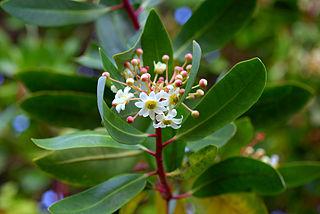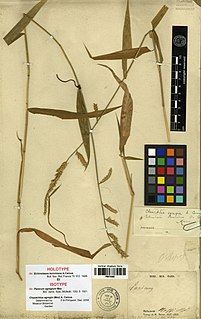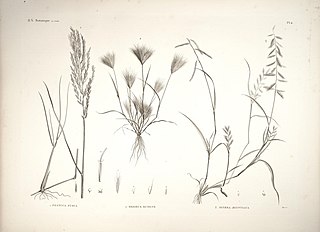
Winteraceae is a primitive family of tropical trees and shrubs including 93 species in five genera. It is of particular interest because it is such a primitive angiosperm family, distantly related to Magnoliaceae, though it has a much more southern distribution. Plants in this family grow mostly in the southern hemisphere, and have been found in tropical to temperate climate regions of Malesia, Oceania, eastern Australia, New Zealand, Madagascar and the Neotropics, with most of the genera concentrated in Australasia and Malesia. The five genera, Takhtajania, Tasmannia, Drimys, Pseudowintera, and Zygogynum s.l. all have distinct geographic extant populations. Takhtajania includes a single species, T. perrieri, endemic only to Madagascar, Tasmannia has the largest distribution of genera in Winteraceae with species across the Philippines, Borneo, New Guinea, Eastern Australia, and Tasmannia, Drimys is found in the Neotropical realm, from southern Mexico to the subarctic forests of southern South America, Pseudowintera is found only in New Zealand, and Zygogynum has species in New Guinea and New Caledonia.

Joseph Marie Henry Alfred Perrier de la Bâthie was a French botanist who specialized in the plants of Madagascar.

Ravenala is a genus of monocotyledonous flowering plants. Classically, the genus was considered to include a single species, Ravenala madagascariensis, commonly known as the traveller's tree, traveller's palm or East-West palm, from Madagascar. It is not a true palm but a member of the family Strelitziaceae. The genus is closely related to the southern African genus Strelitzia and the South American genus Phenakospermum. Some older classifications include these genera in the banana family (Musaceae). Although it is usually considered to be a single species, four different forms have been distinguished. Five other species were described in 2021, all from Madagascar: Ravenala agatheae Haev. & Razanats., R. blancii Haev., V.Jeannoda & A.Hladik, R. grandis Haev., Razanats, A.Hladik & P.Blanc, R. hladikorum Haev., Razanats., V. Jeannoda & P.Blanc, R. madagascariensis Sonn., et R. menahirana Haev. & Razanats.

Panicoideae is the second-largest subfamily of the grasses with over 3,500 species, mainly distributed in warm temperate and tropical regions. It comprises some important agricultural crops, including sugarcane, maize, sorghum, and switchgrass.
Thecacoris is a genus of flowering plant belonging to the family Phyllanthaceae first described as a genus in 1821. It is native to tropical Africa and Madagascar. It is dioecious, with male and female flowers on separate plants, although it may rarely be monoecious.

Melanophylla is a genus of flowering plants endemic to Madagascar. The genus contains seven species of small trees and shrubs.

Brachypodium is a genus of plants in the grass family, widespread across much of Africa, Eurasia, and Latin America. The genus is classified in its own tribe Brachypodieae.

Chasechloa is a grass genus in the tribe Paniceae, endemic to Madagascar. It was described by French botanist Aimée Antoinette Camus in 1948, who named it in honour of Mary Agnes Chase. Its two species were also classified in the genera Echinolaena and Panicum, but phylogenetic analysis confirmed that they form a distinct lineage.

Dinebra is a genus of Asian, African, and Pacific Island plants in the grass family.
Lecomtella is a genus of grasses with the sole species Lecomtella madagascariensis, native to Madagascar. It is the only genus in the tribe Lecomtelleae.

Hydrostachys is a genus of about 22 species of flowering plants native to Madagascar and southern and central Africa. It is the only genus in the family Hydrostachyaceae. All species of Hydrostachys are aquatic, growing on rocks in fast-moving water. They have tuberous roots, usually pinnately compound leaves, and highly reduced flowers on dense spikes.

Alloteropsis semialata, known commonly as black seed grass, cockatoo grass, donkersaad gras, swartsaadgras, tweevingergras, and isi quinti, is a perennial grass distributed across much of tropical and subtropical Africa, Asia and Australia, as well as Papuasia and Madagascar. The genus name Allopteropsis comes from the Greek words "allotrios", meaning "belonging to another", and "opsis", meaning appearance. The specific epithet semialata comes from the Latin "semi" (half) and "ala" (wing), referring to the winged margins of the upper glume.

The flora of Madagascar consists of more than 12,000 species of plants, as well as a poorly known number of fungi and algae. Around 83% of Madagascar's vascular plants are found only on the island. These endemics include five plant families, 85% of the over 900 orchid species, around 200 species of palms, and such emblematic species as the traveller's tree, six species of baobab and the Madagascar periwinkle. The high degree of endemism is due to Madagascar's long isolation following its separation from the African and Indian landmasses in the Mesozoic, 150–160 and 84–91 million years ago, respectively. However, few plant lineages remain from the ancient Gondwanan flora; most extant plant groups immigrated via across-ocean dispersal well after continental break-up.
Oryza punctata is an annual grass in the rice genus Oryza, also known as red rice, related to cultivated rice O. sativa. O. punctata forms clumps or tussocks from 50–120 cm tall. It is a native to tropical Africa and Madagascar but is also found in Thailand and other parts of Indochina. O. punctata is a weed species in commercial rice growing operations although it appears to be rare in its native range. O. punctata has an IUCN status of least concern. It is not generally eaten or used as fodder by farmers but there is some evidence that it has been used as such during periods of famine. Due to the importance of the crop varieties of rice globally, the evolution of the Oryza genus as a whole has been studied extensively. A lot of information about O. punctata has been elucidated as a secondary benefit to this commercial research. O. punctata evolved some 5 million years ago in the second of two rapid radiation events that occurred in the Oryza L. genus.

Paspaleae is a tribe of the Panicoideae subfamily in the grasses (Poaceae), native mainly to the tropical and subtropical Americas but with a number of species introduced to other regions. It includes roughly 680 species in 39 genera. Species in this tribe use either of the C3 or C4 photosynthetic pathways.

Sartidia perrieri is a grass species endemic to Madagascar, known from only one collected individual and now considered extinct.

Aristida rufescens is a grass species native to Madagascar and to Mayotte in the Comoros archipelago. It was described by German agrostologist Ernst Gottlieb von Steudel in 1854.

Loudetia simplex is a grass species found in tropical and Southern Africa and Madagascar. It was originally described as a Tristachya species by Christian Gottfried Daniel Nees von Esenbeck in 1841 and was transferred to Loudetia by Charles Edward Hubbard in 1934.
Elizabeth Anne Kellogg is an American botanist who now works mainly on grasses and cereals, both wild and cultivated. She earned a Ph.D from Harvard University in 1983, and was professor of Botanical Studies at the University of Missouri - St. Louis from September 1998 to December 2013. Since 2013 she has been part of the Kellogg Lab at the Donald Danforth Plant Science Center in Missouri, where she is principal investigator In 2020 she was elected a member of the National Academy of Sciences.

Maria Sergeevna Vorontsova is a Russian-born botanist, specializing in the taxonomy of Poaceae (grasses). She was responsible for authoring the taxon for Solanum agnewiorum and Solanum umtuma. She is a member of the Accelerated Taxonomy department at Royal Botanic Gardens, Kew. She is one of the co-authors and maintainers of GrassBase, and is an editor of the journal, Phytotaxa.
















